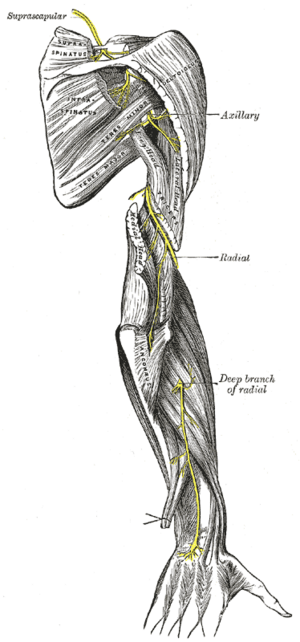Axillary nerve facts for kids
The axillary nerve is an important nerve located in your armpit. It's part of a bigger group of nerves called the brachial plexus, which helps control your arm and hand movements. This nerve carries signals from your brain to certain muscles. It also sends feeling back to your brain from your skin. Sometimes, people call it the circumflex nerve.
Contents
What Does the Axillary Nerve Do?
The axillary nerve is like a two-way street for messages.
- Moving Your Arm: It sends signals from your brain to three important muscles in your arm. These are the deltoid muscle (the big, rounded muscle on your shoulder), the teres minor (a smaller muscle that helps rotate your arm), and a part of the triceps brachii muscle (the muscle at the back of your upper arm). These muscles help you lift, rotate, and move your arm.
- Feeling Things: It also sends messages back to your brain. It tells your brain about feelings from your shoulder joint and from the skin over a small part of your upper arm. This helps you know if something is touching your shoulder or if your arm is in a certain position.
What Happens if the Axillary Nerve Gets Hurt?
The axillary nerve can sometimes get injured. This might happen if your shoulder gets dislocated. It can also happen if your armpit is squashed, for example, by using a crutch incorrectly. A broken arm can also sometimes hurt this nerve.
If the axillary nerve is injured, you might notice a few things:
- Trouble Moving Your Arm: The deltoid muscle and teres minor muscle might become paralyzed. This means you can't move them. It makes it hard to lift or move your arm, especially sideways. Your shoulder might also look a bit "flat" because the deltoid muscle isn't working properly.
- Loss of Feeling: You might lose feeling in a small area of skin on the side of your upper arm. This means you might not feel touch or temperature in that spot.
Images for kids
See also
 In Spanish: Nervio axilar para niños
In Spanish: Nervio axilar para niños

All content from Kiddle encyclopedia articles (including the article images and facts) can be freely used under Attribution-ShareAlike license, unless stated otherwise. Cite this article:
Axillary nerve Facts for Kids. Kiddle Encyclopedia.




